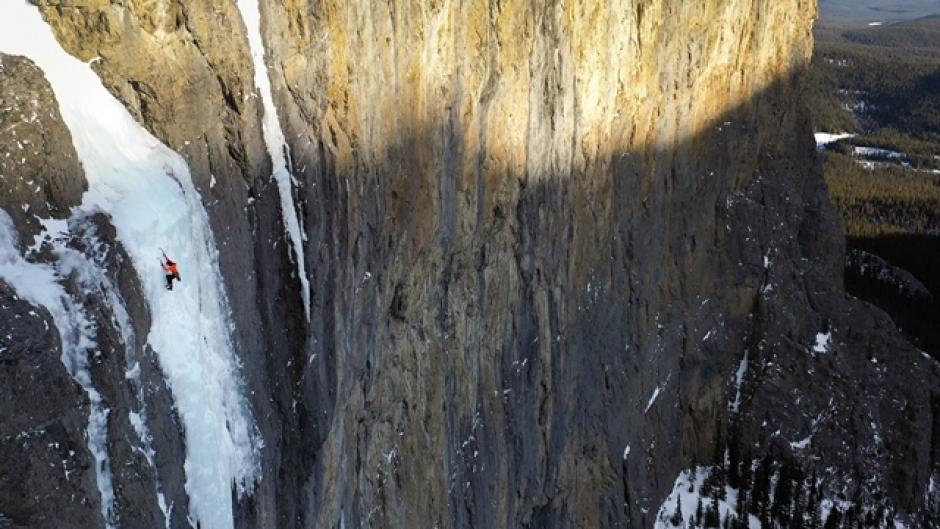You Have to Watch ‘Not Alone,’ a Climbing Film About Death, Suicide and Hope
Heather Mosher's new film focuses on a tragic avalanche death, the survivors and how a group called Mountain Muskox aims to help

There’s a lot of death in the world of climbing, but there’s not a lot of films that focus on what happens to those involved after a death. However, a new film by Squamish-based Heather Mosher does just that.
I was lucky to be at the world premiere for Not Alone at the Banff Mountain Film Festival this weekend. The description of the 45-minute film read, “After an ice climbing avalanche takes the life of her friend, professional athlete and alpine guide Sarah Hueniken finds herself questioning everything about her life in the mountains.”
In 2019, Sonja Johnson Findlater died in an avalanche while at the base of Massey’s, a WI4 in Field, B.C. It was during a multi-day course organized by Hueniken. Findlater and Hueniken were best friends, and Findlater was an experienced ice climber. Her death rocked the local climbing community, and sent Hueniken into a world of depression.
The film starts with Hueniken narrating over scenes of her on the ice climb Hydrophobia. She says, “We all live in these mountains because this is where we get life from. And when it takes life from us, how do you keep living in it.”
Early in the film, we get a glimpse of Hueniken’s motivation and stoke for climbing. Her life partner, the legendary ice climber Will Gadd, informs the audience that she was the first North American woman to climb M11, M12, M13 and M14. Their love and affection for one and other is clear, and their support on difficult climbs is amazing.
We’re then shown footage from past ice climbing clinics that Hueniken ran for women. It’s an uplifting and inspiring few minutes, where we meet participants and friends sharing time on the ice and in huts.
Before we’re 10 minutes into the film, there’s a reenactment of the moment the avalanche took place on Massey’s. Hueniken saw the avalanche while on the ice climb Professor Fall’s, and then ran along a train track with a moving train to help. Fellow guide, Merrie-Beth Board, who was in the avalanche is brought into the film to talk about the tragic moments after the snow settled.
This is when the energy of the film shifts in a dramatic way from climbing to a death. You can’t help but be overwhelmed with sadness as the news breaks that Findlater passed away in a hospital a few days after the avalanche.
Mosher then brings us with Hueniken through the absolute worst moments of her life after the avalanche. “I feel like I had to get out of my body,” said Hueniken. “And, how do you do that?”
Alpinist and mountain guide Barry Blanchard is brought into the film at this point. He talks about his fatal guiding accident that happened in 1986, and how he lost two guests after a big fall on a snow slope, which he was part of.
Blanchard then talks about feeling alone and how he wouldn’t be surprised if Hueniken had considered suicide. Hueniken then says that she would go toward dangerous places to see what she would do. Gadd then says, “So you feel so shitty that you want to kill yourself. How do you talk about that? We have no vocabulary to talk about that.”
Blanchard then drops a figure that blew everyone away. He said that the suicide rate for snow safety specialists and mountain guides is six times higher than the national average. “I do know of other guide who’ve taken their lives because of avalanche fatalities.”
Around mid-way through the film, Hueniken decides to focus on a climbing goal, something that she can train for. She picks a one-day link-up of Cryophobia, Nophobia and Hydrophobia in the Ghost. It would be a 15-pitch outing with climbing up to M10 and WI6.
Mosher masterfully transitions the film away from one of dread and death to one of hope and steep technical climbing. Hueniken has always been a climbing hero of mine, one who crushes difficult terrain, and seeing her focus and strength during cold nights of winter camping and on huge overhanging routes is moving.
More climbers are introduced to the film, the ones who supported Hueniken on her phobia link-up, which you can read about here. The cinematography of Hueniken on Nophobia would make a brilliant climbing film in and of itself. Her fight on the crux M10 are the best multi-pitch drytool clips I’ve seen.
After her epic one-day push, we’re brought to Haffner Creek where friends and family of Findlater have gathered on the one-year anniversary of her death in March 2020. It’s a touching tribute and one that left many people in the audience teary-eyed.
The film ends on a high note and we’re introduced to Mountain Muskox, a group designed to help survivors of traumatic accidents and loss. Hueniken and Blanchard talk about the process of healing, and about the importance of community. Read more about the ever-so-important Mountain Muskox here.
In my opinion, this is one of the most important climbing films ever made. Mosher has done an exquisite thing with Not Alone, one that I hope everyone gets a chance to see. It’s available to view online thanks to the virtual Banff Mountain Festival here.


